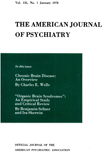CLASSIFICATION AND REALLOCATION OF "EXHAUSTION" CASUALTIES IN A THEATRE OF WAR
Abstract
Almost all the psychiatric battle casualties could be retained in a theatre of war performing useful duties. The proportion returned to combatant duties after brief treatment in forward areas without being severed from their units was encouraging but return to combatant duty after treatment in neuropsychiatric units was possible in only a small proportion of cases. "Exhaustion" accounted for about 10 percent of battle casualties, exclusive of killed and missing. Relief of severe symptoms was comparatively easily obtained and men continued to be capable of performing duties in the rear without excessive sickness or crime rates but anxiety was stirred up by prospect of return to action—or briefly by incidental enemy air activity. There was little reason to expect that much improvement in rates of psychiatric battle casualties could have been brought about either by selection or treatment. It was obvious in case after case that childhood insecurity was the outstanding cause of predisposition and amelioration of much of this insecurity should have been possible. An editorial in the B. M. J. of March 7, 1942 concludes: "The last war emphasized the importance of mental conflict; this war has on the whole emphasized the importance of predisposition and especially of constitutional predisposition. One of the tasks of the future is to discover means of detecting this in a much higher proportion of cases than is possible now." However, it seems that by 1944 in the Canadian Army selection had been carried as far as it could be without being wasteful. Because of that observation and because of opinions developed after examination of a large number of individual soldiers my conclusion would be that the task of the future would be to reduce the amount of this constitutional predisposition. I think that current usage of the term constitution does not imply that it can be modified only by eugenics. I think that better socialization and better attention to individual mental hygiene provide the answer. A study of all possible experiences during the war could teach us a great deal about how individuals could be more adequately socialized. Ronald Fairbairn concluded one of the best articles I have seen about war neuroses (B. J. M., Feb. 13, 1943) with indications of his discouragement in efforts to deal with separation anxiety en masse, and the statement—"What these people really need is not a psychotherapist but an evangelist." Although in peace time more deliberate and individualized methods of bringing about the identification of persons with society should be more efficient than evangelism, its appeal implies useful clues.
Access content
To read the fulltext, please use one of the options below to sign in or purchase access.- Personal login
- Institutional Login
- Sign in via OpenAthens
- Register for access
-
Please login/register if you wish to pair your device and check access availability.
Not a subscriber?
PsychiatryOnline subscription options offer access to the DSM-5 library, books, journals, CME, and patient resources. This all-in-one virtual library provides psychiatrists and mental health professionals with key resources for diagnosis, treatment, research, and professional development.
Need more help? PsychiatryOnline Customer Service may be reached by emailing [email protected] or by calling 800-368-5777 (in the U.S.) or 703-907-7322 (outside the U.S.).



